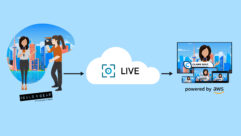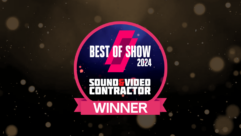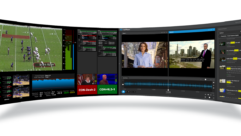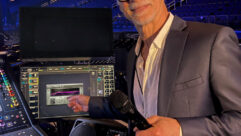Working the Show
Mar 20, 1997 12:00 PM,
Ted Uzzle
With your handy program book as your tarot deck, you can plan your future at NSCA ’97.Based on official trade show hours, we have less than three minutes to spend with each exhibitor. Of course, we won’t be visiting each and every one of them, but we want to visit as many as possible. That requires time management, strategy and trade show savvy. Here are the best hints, tips and tricks we’ve heard from trade-show old-timers. Each has been tested and found practical and valuable.
Formulate goals: List the most important things you want to accomplish at the Expo. If you are a contractor, you might want to investigate a product category, with an eye toward finding a new vendor or replacing a vendor giving you problems. If you are a consultant, you might target new companies whose product information you wish to receive. If you are an installer or service representative, you might focus on companies that make tools and test instruments.
Use the Expo listings: This issue lists every company at the Expo, with a brief listing of what they’re showing this year. It’s your first stop to find “must see” companies and plan ahead for the Expo.
Read the ads: Many companies exhibiting at NSCA advertise their new and interesting products. Be sure to examine the ads in this preview issue of S&VC, in the on-site program book and in the show daily. When a product catches your eye, write it down for further investigation.
Decide which booths to visit: List companies to visit, with their booth numbers. Make this list in any order, but when it’s about complete, copy it over in order of booth number and draw a line every time booth numbers go up to the next hundred. You now have a list by aisle of the companies you want to see, and you can work them in convenient order, with a minimum of rushing from aisle to aisle.
Make appointments with people you know: It’s very frustrating to miss the particular person you want to see, whether it’s an exhibitor or another Expo visitor. Make appointments with them for a particular time and place. If these appointments are outside Expo hours, it preserves your time for seeing exhibits. For example, you might want to make an appointment at a certain company’s booth for closing time and go from there to someplace quiet for a talk. You’re welcome to meet at the S&VC booth, number 616. It’s conveniently located, it has reading material if you must wait, and nobody will try to sell you anything.
Dress comfortably: Its informality is one of the great features of the Expo. Don’t dress as if you’re going to a job interview; leave the Armani suits and wingtips at home. You’re the customer, and you don’t need to impress the exhibitors. Let them dress up to impress you. Wear walking shoes that are light, fit you properly and provide good arch support. Last year in St. Louis a seam split in one of my shoes, and I had to go out and buy a new pair. Avoid that at all costs; my dogs barked throughout the Expo.
Leave your briefcase at home: Buy a bag that will go over your shoulder, leaving both your hands free. These bags come with straps shaped to fit the shoulder, so they won’t slide off all the time. This way you can rummage around in the bag without needing a flat surface to lay it on. Also, you are less likely to walk off without it. One good product is the back-saver bag from BackSaver Products, 800-251-2225.
Manage business cards: Go to the office-supply store to buy one of those booklets with plastic slots for business cards. Fill it with your own business cards, so when you receive someone else’s card, you make a place for it by taking out one of yours.
Manage miscellaneous notes and reminders: While you’re at the office-supply store buy a deck of spiral-bound, perforated 3—5 cards. Use these for notes. Slips of plain paper get scrunched together at the bottoms of pockets and folders. Stiffer cards hold their shape and are harder to lose.
Safe travel: Send a stamped, self-addressed business envelope to the American Society of Travel Agents, 1101 King St., Alexandria, VA 22314, for a copy of its free booklet, Travel Safely.
Hotel safety: Ask for a room on the lowest floor available. When you go to the room, check the peephole in the door; you may find the lens has been reversed so someone can see in, but you can’t see out. Know how to get to the stairwell from your room. Don’t hand in your key at the desk when you go out for the day. If you go out in the evening, leave on a light and the radio or television. Carry the telephone number of the hotel with you everywhere you go.
Work the slow times: The Expo is very crowded and busy at certain times. Be sure to work the slow times for maximum efficiency. You’ll have the place to yourself at the opening bell every day except the first and throughout the last day. If you can travel to the Expo for one day only, make it the last day.
Start at the back of the hall: Instead of following the crowd down the main aisle nearest the door, go to the rear of the hall, away from the entrance. It’ll be much less crowded there, and you can see whatever you want.
Wear your badge: Be sure to wear your badge in the center or on your right side, where it will be most visible when you shake hands. Be sure it’s not hidden by a lapel.
Introduce yourself: Although you’re not required to introduce yourself to someone in a booth at the Expo, it is certainly a friendly thing to do and may well result in more forthcoming offers of assistance. Walk right in, stick out your hand, and tell them your name and what you do for a living. Who knows? This might be someone you’ll do business with for years.
Steer the conversation: If you’ve come by to find out something in particular, just ask. Get down to business. You’re there for a purpose. Keep to it. Afterwards, if you’re interested (and only if you’re interested), let them launch into a tour of every knob and push button in the booth. Sometimes we think we’re merely being polite standing there and listening to the rehearsed spiel. Wrong. It’s not polite to let them waste their time and your time telling you about things that don’t interest you.
Give a business card: If they’re going to send you something after the Expo, take out one of your business cards, turn it over and write a note about what you want them to send you. Then give them the card. They will want your badge to run through a gizmo, but a business card is good insurance, and it records precisely what you are asking the company to do for you.
Explore new business areas: The Expo is the perfect place to investigate related businesses you might want to expand into. Don’t be embarrassed to say, “I’m not in this area of the business now, but I’ve been thinking about it. What can you tell me?” Zero in on training programs the exhibitors may have to help you get started.
See unfamiliar companies: Set aside some time to visit companies you’ve never seen before. This may be their first Expo. Of course, it may be their last; new companies come and go. But this company could be the major player in a product category five years from now. That has happened many times.
Put lunch time to work: Eating alone, bolting that dreadful hot dog because time’s-a-wasting, is bad for your health and poor use of time. Appoint a time and place to get together with colleagues from your company to trade must-see booth numbers. If you are eating alone, ask to sit at a table with others (it helps if it’s crowded), introduce yourself, and ask what they’ve seen that impressed them.
Really put lunch time to work: Look into NSCA’s innovative “Lunch & Learn” program, appearing for the first time this year. Sign up for $25; they give you a box lunch and a drink when you go in; while you eat, you’ll hear a professional speak on valuation of your business (Friday), strategic planning (Saturday) and getting and keeping customers (Sunday). These promise to be especially good. You’ll be back on the floor in an hour, with a meal and a hundred new ideas.
Show break-down: As a matter of kindness and courtesy to exhibitors, leave the floor at closing time the last day. Exhibitors have a limited time to box everything up and ship it out and would like to get right to it. Maybe they have a plane to catch, or maybe they’d just like to get to dinner before 11 o’clock.
Follow up: Don’t wait until next year’s Expo in Las Vegas to get to companies you weren’t able to see this time. Use the listings in this issue or in the on-site program book to contact companies whose booths were always crowded or where you weren’t able to find the right person and the right time.
Review the Expo for colleagues who didn’t go: When you get back to your office, get everyone together to discuss what you saw that might interest them. This spreads the benefit of the Expo throughout your organization. Often, these people might want to follow up on something you saw in Charlotte.
The NSCA Expo is an Aladdin’s cave of priceless opportunities to advance your business and your career. You must know what you want, be aggressive and go right in there and get it.
Uzzle is editor of S&VC.










